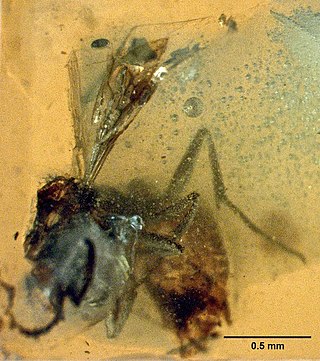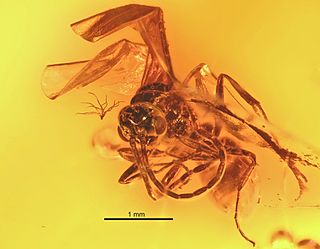
Tapinoma is a genus of ants that belongs to the subfamily Dolichoderinae. The genus currently comprises 74 described species distributed worldwide in tropical and temperate regions. Members of are generalized foragers, nesting in a wide variety of habitats, ranging from grasslands, open fields, woodlands, to inside buildings. The majority of species nest in the ground under objects such as stones or tree logs, other species build nests under bark of logs and stumps, in plant cavities, insect galls or refuse piles.

Haidomyrmecinae, occasionally called hell ants, are an extinct subfamily of ants (Formicidae) known from Cretaceous fossils found in ambers of North America, Europe, and Asia, spanning the late Albian to Campanian, around 100 to 79 million years ago. The subfamily was first proposed in 2003, but had been subsequently treated as the tribe Haidomyrmecini and placed in the extinct ant subfamily Sphecomyrminae. Reevaluation of the Haidomyrmecini in 2020 lead to the elevation of the group back to subfamily. The family contains the nine genera and 13 species.

Haidomyrmodes is an extinct genus of ant in the formicid subfamily Haidomyrmecinae, and is one of only nine genera placed in the subfamily Haidomyrmecinae. The genus contains a single described species, Haidomyrmodes mammuthus. Haidomyrmodes is known from several Middle Cretaceous fossils which have been found in Europe.

Burmomyrma is an extinct genus of aculeate hymenopteran, suggested to be an ant. The genus contains a single described species, Burmomyrma rossi. Burmomyrma is known from a single Middle Cretaceous fossil which was found in Asia.
Pristomyrmex rasnitsyni is an extinct species of ant in the genus Pristomyrmex. The species is known from a single Late Eocene fossil which was found in Europe.
Armaniidae was a name formerly given to a group of extinct ant-like hymenopterans known from a series of Cretaceous fossils found in Asia and Africa. Armaniidae has been suggested by several authors to belong to the family Formicidae as one of the stem-group subfamilies, Armaniinae; however, this position has not been taken up by myrmecologists. The family contained seven described genera and thirteen described species. An analysis of fossil ants based on antenna structure in 2017 resulted in three of the family being broken up with some genera being moved to Sphecomyrminae and other genera being relegated to incertae sedis in Formicidae or Aculeata.

Yantaromyrmex is an extinct genus of ants first described in 2013. Members of this genus are in the subfamily Dolichoderinae of the family Formicidae, known from Middle Eocene to Early Oligocene fossils found in Europe. The genus currently contains five described species, Y. constrictus, Y. geinitzi, Y. intermedius, Y. mayrianum and Y. samlandicus. The first specimens were collected in 1868 and studied by Austrian entomologist Gustav Mayr, who originally placed the fossils in other ant genera until the fossils were reviewed and subsequently placed into their own genus. These ants are small, measuring from 4 to 6 mm in length and can be characterized by their trapezoidal shaped head-capsules and oval compound eyes that are located slightly to the rear of the capsules midpoint, with no known ocelli present.
Dolichoderus brevicornis is a species of ant in the genus Dolichoderus. Described by Dlussky in 2002, remains of the species were discovered in the Baltic Amber.

Dolichoderus longipilosus is an extinct species of Eocene ant in the genus Dolichoderus. It was described by Dlussky in 2002, and the fossils of the species are only known from a fossilised worker that was found in the Baltic amber.

Dolichoderus nanus is an extinct species of Eocene ant in the genus Dolichoderus. Described by Dlussky in 2002, a fossilised worker was discovered in the Baltic amber.
Dolichoderus polessus is an extinct species of Eocene ant in the genus Dolichoderus. Described by Dlussky in 2002, a fossilised worker was discovered in the Rivne amber.
Dolichoderus polonicus is an extinct species of Eocene ant in the genus Dolichoderus. Described by Dlussky in 2002, a fossilised worker was discovered in the Baltic amber.
Dolichoderus robustus is an extinct species of Eocene ant in the genus Dolichoderus. Described by Dlussky in 2002, a fossilised worker was discovered in the Rivne amber.
Dolichoderus zherichini is an extinct species of ant in the genus Dolichoderus. Described by Dlussky and Perkovsky in 2002, the fossils were discovered in the Rovno amber, located in Ukraine.
Tapinoma electrinum is an extinct species of ant in the genus Tapinoma. Described by Dlussky in 2002, fossils of the species were found in the Rovno amber in Ukraine, where a fossilised male of the species was described.

Pachycondyla succinea is an extinct species of ant in the formicid subfamily Ponerinae described from fossils found in Europe. P. petrosa is one of three middle Eocene Pachycondyla species found in Baltic amber.

Nylanderia pygmaea is an extinct species of formicid in the ant subfamily Formicinae known from fossils found in the Baltic region.
2020 in paleoentomology is a list of new fossil insect taxa that were described during the year 2020, as well as other significant discoveries and events related to paleoentomology that were scheduled to occur during the year.
Jouault, Corentin; Rosse-Guillevic, Simon. "A new genus of praeaulacid wasp from the mid-Cretaceous Kachin amber (Myanmar)". Annales de Paléontologie. 109 (1): 102599. doi:10.1016/j.annpal.2023.102599.








